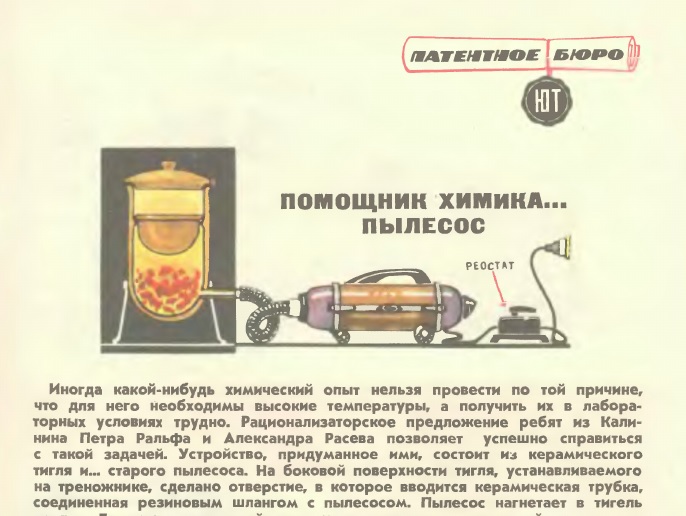 I’m not able to make out the text, but this Soviet magazine from November 1967 appears to be right up our alley. It appears to be giving young comrades instructions for building a home blast furnace!
I’m not able to make out the text, but this Soviet magazine from November 1967 appears to be right up our alley. It appears to be giving young comrades instructions for building a home blast furnace!
I am able to make out the caption for the item between the vacuum cleaner and the wall outlet, and it’s marked “rheostat.” Presumably, it’s set to blow air into the combustion chamber, and the young Soviet mad scientist can adjust the intensity of the furnace with the rheostat.
The illustration appeared in the November 1957 issue of Юный техник magazine. A treasure trove of similar magazines, many on the subject of radio, can be found at Журналы СССР.
Contrary to first impression, the logo at the top of the page is Ют, the abbreviation for the name of the magazine. But if it looked like HOT at first glance, we don’t blame you. This contraption will indeed get hot!
We put this item in the “science fair ideas” category. However, we do recommend that before duplicating this project, young scientists should have the article translated to see if it contains any safety warnings. I suspect some might be called for.

Here’s a full translation:
Vacuum cleaner – a chemist’s helper
Sometimes an experiment requires high temperatures unobtainable in the common laboratory. Petr Ralph and Alexandr Rasev from Kalinin have successfully solved this problem. Their invention consists of a ceramic crucible and…an old vacuum cleaner. The crucible with a hole on its side is mounted on a tripod and then connected with the vacuum cleaner’s hose via a ceramic pipe. The vacuum cleaner pumps the air inside the crucible. Either pure charcoal or a mix of charcoal and coal can be used as fuel. The temperature inside is regulated by a rheostat included in the circuit, as depicted. It is high enough for a spectrum of interesting experiments, including even alloying certain metals. Chemical agents are inserted from above the crucible by a special crucible spoon.
As you can see, it is very simple. Although air blasting has been known for centuries, our students found this new application for it.
Спасибо!